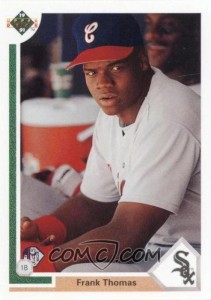The Card
When looking at the front of the card, I found myself wondering where they took this photo. I knew that Jefferies had played a lot of second base, but he looks to be playing third in the photo. Then something else struck my nerve: the uniform has the “New York” in script. I knew that the Mets wore that uniform in 1987, but they went to the block “New York” in 1988.
I did some more digging and realized that Jefferies didn’t play the field in his call-up in 1987, so this photo must have been taken during a practice or warm-up session. Most of the people look to be standing up in the background. Maybe hunting for autographs?
The thing that I always loved about this card was the fact that Jefferies forearm looked like it was going to explode. He was never a very big guy, but that forearm vein looks like it could pop at any second and he would be left with one arm.
The back of the card shows just how dominant of a Minor League player he was. He was the Minor League Player of the Year in both 1986 and 1987. I love the quote on the back as well:
“He has the quickest bat I’ve ever seen,” claimed Bill Walberg.
In 1988, I was right in the middle of my collecting prime. I was 13 years old, had a job as a paperboy, and had spending money to waste on my hobbies. The 1988 Score set was great because it was printed on a fairly nice card stock but wasn’t as expensive as Donruss or Fleer.
I was a huge Mets fan, Jefferies was the second coming of Ted Williams, and I collected a ton of these cards. I remember going to the card shop in 1988 and seeing them going for $80 behind the case. I thought I was rich.
You can get the card for $0.50 on any card site these days.
The Player
Jefferies the player was one of the most hyped players coming out of the minors leagues. He had a laid back California attitude and that seemed to rub the New York media the wrong way. Combine that attitude with the hyper-egos of that New York Mets roster (Gooden, Hernandez, Strawberry, Carter) and it was a recipe for disaster.
The second issue with Jefferies is he wasn’t a very good fielder. He had played shortstop, third, and second in the minors, but never very well. After spending much of the 1988 season in the minors, the Mets didn’t have a place for him to play and it resulted in the Mets trading the very popular Wally Backman to give Jefferies the starting second baseman spot for the 1989 season.
Jefferies spent the next three years with the Mets trying to live up to the hype and was never able to do so. After leaving New York, he had two great seasons playing first base for the Cardinals in 1993 and 1994. I think one of the things that really hurt his reputation was that the power numbers never came, and even though he stole 196 bases in his 14 year career, he wasn’t particularly fast, either.
He was probably the most naturally gifted hitter that I ever saw in my lifetime. But those naturally given gifts do not always equal production value. I loved watching him in New York, and I wish the fans, media, and teammates had all given him his fair shake with the Mets. We all know that New York is a different beast, though.









